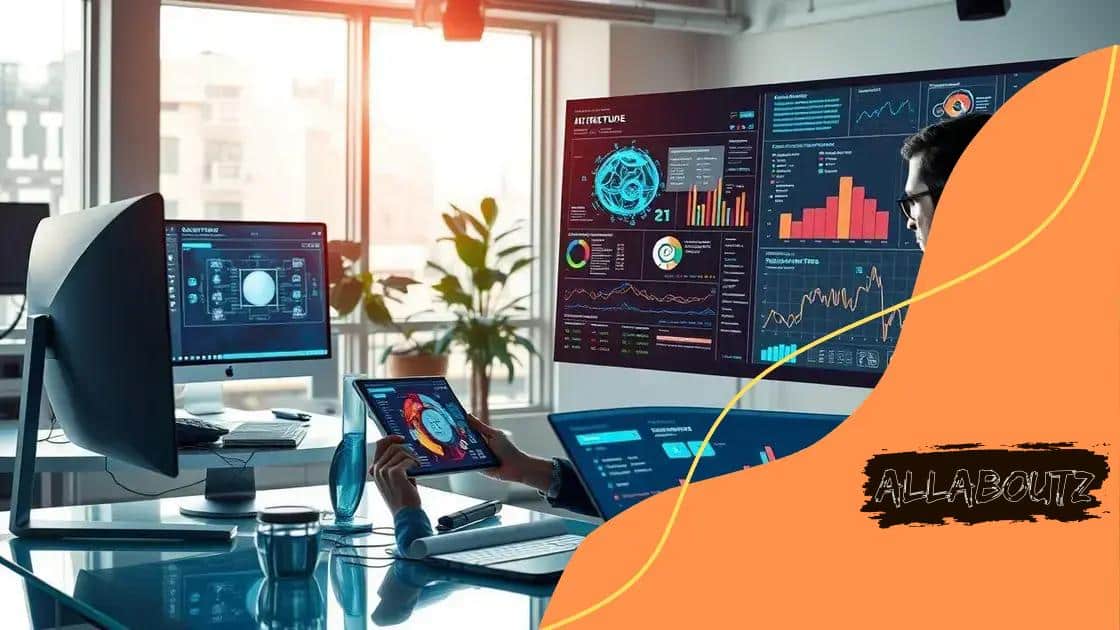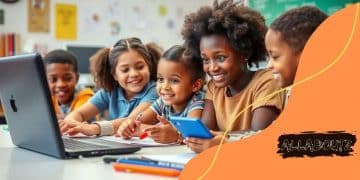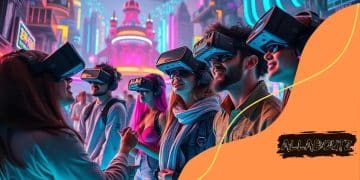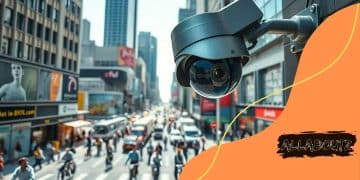The role of AI in transforming the creative industries

The role of AI in transforming the creative industries involves enhancing artistic expression through innovative tools while presenting challenges such as originality concerns and ethical implications.
The role of AI in transforming the creative industries is becoming increasingly significant. Have you noticed how technology is reshaping how we express ourselves and create? Let’s dive in and explore this fascinating evolution.
Understanding AI’s impact on creativity
Understanding AI’s impact on creativity reveals how technology is changing the landscape for artists and creators. As we explore this transformation, it’s essential to recognize that AI is not just a tool but a collaborator that can enhance human creativity.
With the rise of AI-driven applications, artists can now expand their capabilities. They can generate ideas and explore new styles they may not have considered otherwise. This technology allows creators to push boundaries and venture into unexplored territories.
How AI is Enhancing Creative Processes
Many artists are now integrating AI into their workflows. This partnership can lead to innovative outcomes. Some ways AI is enhancing creative processes include:
- Generating unique designs based on user preferences.
- Automating repetitive tasks, allowing artists to focus on creativity.
- Providing insights and suggestions during the creative process.
- Facilitating collaboration between different art forms.
AI can analyze trends and styles from vast datasets. This capability helps artists stay relevant in a fast-paced world. By understanding what resonates with audiences, creators can tailor their work accordingly.
Case Studies of AI in Art and Media
Many successful case studies show how AI impacts various creative fields. For example, artists are using machine learning algorithms to create stunning visuals. Some musicians collaborate with AI to compose new songs, blending human emotion with data-driven suggestions.
Moreover, filmmakers are utilizing AI for scriptwriting and editing. These advancements open up new avenues for storytelling, making the process more efficient than ever.
As AI develops, its role in creativity will likely expand. The future may bring even more advanced collaborations, enhancing our creative landscapes in ways we cannot yet imagine.
How AI tools are empowering artists
AI tools are empowering artists in exciting ways that transform traditional creative practices. Many creators are now discovering how artificial intelligence can enhance their work while also saving time and resources.
Artists are using AI software to generate new ideas and designs. This technology acts as a partner, suggesting various styles or color schemes, which allows artists to explore more options than ever before. As they collaborate with AI, their creativity expands, leading to innovative outcomes.
Key Benefits of Using AI Tools
Some of the most notable benefits of AI tools for artists include:
- Increased efficiency in the creative process.
- Personalized recommendations based on past work.
- Automated tasks that free up time for creativity.
- Enhanced engagement with their audience through data analysis.
AI innovations also enable artists to produce art in unique ways. For instance, many musicians use AI to compose melodies or harmonies they might not have thought of alone. This cross-pollination of human and machine creativity can produce surprising and delightful results.
Popular AI Tools for Artists
Several AI tools have gained traction among artists looking to enhance their workflow. Popular examples include:
- DeepArt, which transforms photos into artistic styles.
- Amper Music, allowing musicians to compose original music easily.
- Daz 3D, helping creators produce 3D art seamlessly.
- Runway ML, which has tools for video editing and animation.
The role of these tools is significant in helping artists innovate and stay relevant in the rapidly changing creative landscape. As technology advances, the collaboration between artists and AI will likely grow stronger, leading to unprecedented artistic expressions.
Case studies of AI in design and media

Case studies of AI in design and media show how artificial intelligence is reshaping creative industries. These examples highlight the innovative collaborations between artists and technology, leading to remarkable breakthroughs.
For instance, a famous advertising agency utilized AI to create a successful ad campaign that resonated with audiences on multiple platforms. By analyzing data, the AI suggested themes and designs that connected emotionally, ultimately driving engagement and sales. This case illustrates how data-driven insights can enhance creative decisions.
Notable Examples in Design
In the design field, AI tools like Adobe Sensei are making waves. Adobe Sensei improves workflows by automating time-consuming tasks such as photo editing and layout design. This allows designers to focus more on creativity rather than repetitive actions.
- AI-powered design tools can suggest layouts based on user input.
- Automated editing simplifies complex photo adjustments.
- Real-time feedback helps designers iterate quickly.
Another remarkable example is the fashion industry, where AI analyzes trends to predict popular styles. Brands apply these insights to create collections that resonate with consumers, ensuring they remain relevant.
Impact on Media Production
In media production, AI is transforming storytelling. One recent project involved an AI algorithm generating scripts for short films. Creators provided themes, and the AI produced unique stories to explore. This approach opens new avenues for filmmakers.
In addition, AI algorithms analyze audience feedback to improve content delivery. Streaming services frequently use these technologies to recommend shows and movies based on viewing history, enhancing user experience.
These case studies illustrate the expanding role of AI across creative fields. As technology evolves, it will continue to unlock new possibilities for artistic expression, altering how creatives work.
Challenges artists face with AI
Challenges artists face with AI are significant and varied, requiring careful consideration. While artificial intelligence offers new tools for creativity, it also poses hurdles that creatives must navigate.
One major challenge is the fear of losing originality. Many artists worry that reliance on AI might dilute their personal style. They may feel pressured to conform to what AI suggests, potentially stifling their unique voices and perspectives. This concern leads some to resist using AI altogether, thinking it might take away from their artistry.
Ethical Concerns in AI Use
Ethics surrounding AI also play a crucial role in the creative process. Artists grapple with questions of ownership when AI creates art. Who truly owns a piece made with AI assistance? Understanding copyright issues is essential for artists to protect their work.
- Attribution dilemmas can arise when AI-generated work resembles existing pieces.
- There’s a risk of plagiarism if not carefully monitored.
- Artists need to be transparent about using AI in their projects.
Another challenge is the technological divide. Not all artists have the same access to advanced AI tools. Some creators may lack the resources or knowledge to utilize AI effectively, creating disparities in the industry.
Balancing Human Creativity and AI
Furthermore, artists must find a balance between using AI and maintaining their creative instincts. Relying too much on technology can result in a loss of the emotional depth that comes from human experience. Successful artists thrive when they blend their unique insights with the capabilities of AI, creating work that is both innovative and deeply personal.
These challenges highlight the complexity of integrating AI into artistic fields. As technology evolves, artists must continuously adapt, ensuring they retain their voices while exploring new creative horizons.
The future of creativity with AI integration
The future of creativity with AI integration looks promising and innovative. As artificial intelligence continues to evolve, it transforms how artists and creators approach their work.
One exciting aspect is the ability of AI to assist in the creation process. New tools can generate music, art, and even literature, offering inspiration and new ideas to artists. This collaboration allows creators to explore new styles and push traditional boundaries. The potential for unique artistic expressions is greater than ever.
Emerging Technologies in Art
Technologies like generative art are becoming more popular. These systems use algorithms to produce paintings and designs based on user input. Artists can provide parameters, and the AI will create multiple variations to choose from. This process saves time and inspires fresh ideas.
- AI can simulate various artistic techniques.
- Real-time feedback allows for rapid experimentation.
- Collaborative projects between humans and AI lead to innovative outcomes.
Moreover, AI can help in understanding audience preferences by analyzing trends. This data enables artists to create more relevant and engaging content. By tapping into audience insights, creators can tailor their work to connect better with viewers.
The Role of AI in Accessibility
AI also plays a vital role in making art more accessible. For instance, AI tools can aid individuals with disabilities, ensuring everyone can express their creativity. This increased inclusivity broadens the artistic community and enriches diverse voices in the creative space.
As we look ahead, the integration of AI into creativity will likely redefine the artistic landscape. Artists who embrace these technologies will find new ways to express themselves, connecting with audiences in deeper and more meaningful ways.
FAQ – Frequently Asked Questions About AI in Creative Industries
How does AI enhance creativity for artists?
AI provides tools that help artists generate new ideas, automate tasks, and explore different styles, thereby enhancing their creative process.
What challenges do artists face when using AI?
Artists may struggle with concerns about losing originality, ethical issues regarding ownership, and access to technology.
Can AI make art more accessible?
Yes, AI tools can help individuals with disabilities create art, making the creative process more inclusive for everyone.
What future opportunities does AI present for creativity?
AI will continue to expand artistic boundaries, allowing for innovative collaborations between human creativity and technology.





